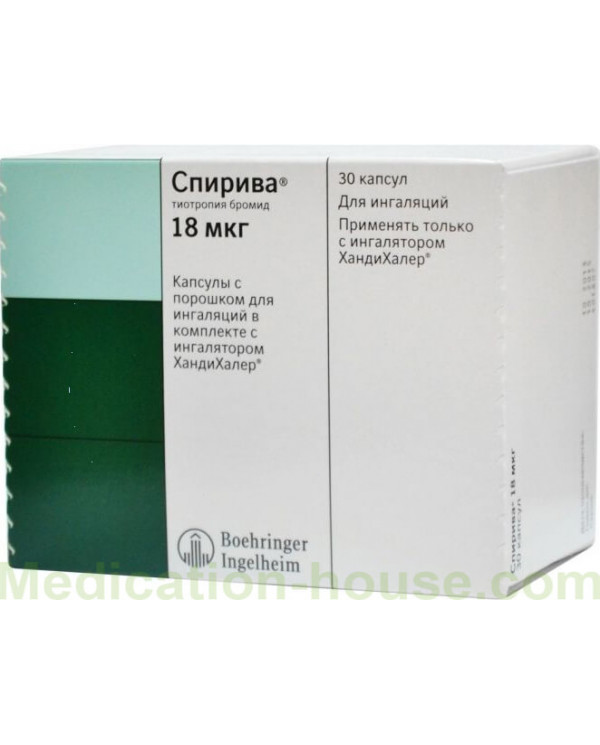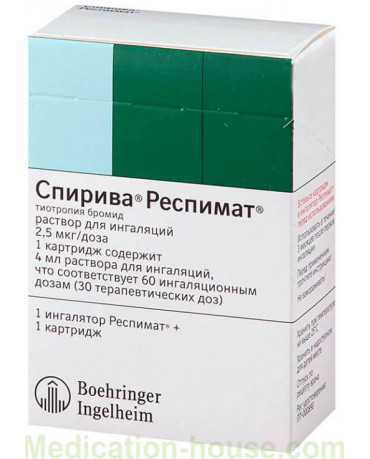Instruction for Spiriva
Reed more and buy Spiriva on this page
The safety and effectiveness of Spiriva exposure has been proven by repeated clinical studies. The drug is able to reduce dyspnea attacks (dyspnea), and reduce the frequency of COPD deterioration.
Dosage form
The product is made in the form of hard capsules filled with a powdery substance for inhalation. The shell of the capsules is a gelatinous, greenish-bluish hue, engraved with the logo of the manufacturer. Encapsulate is a white fine powder.
Packings consist of 10, 30 or 60 capsules enclosed in blisters. They are equipped with a special HandiHaler inhaler (or without it) and are accompanied by instructions with the rules of use.
Composition
The pharmaceutical composition is formed due to the main active substance - tiotropium bromide with a dosage of 22.5 μg, which is the equivalent of 18 μg tiotropium.
Also for the manufacture of the product were used such ingredients as: micronized disaccharide, 200 M, lactose monohydrate.
The constituent ingredients that make up the capsule shell are: macrogol, indigo disodium salt, titanium dioxide, yellow iron oxide, gelatin.
Indications for use
Spiriva capsules are prescribed and used for:
supportive care for patients with COPD, prolonged pneumonia, or pulmonary emphysema (J43);
adjunctive therapy to eliminate shortness of breath attacks;
health promotion impaired due to COPD;
prevention of relapse of lung disease;
additional support for patients with bronchial asthma (J45) and persistent symptoms of the disease.
Pharmacodynamics
Tiotropia bromide is a selective inhibitor of muscarinic receptors with a long exposure time. In medical practice, this substance has received a special designation - an anticholinergic agent. Tiotropium has maximum similarity with all receptors from M1 to M5. Subtype M3 promotes relaxation of the smooth muscle structure of the respiratory tract. Spiriva exhibits bronchoprotective efficacy of a dose-dependent nature and retains its strength throughout the whole day. This duration of the saved effect is explained by the release from the M3 receptors at a fairly leisurely pace. The half-life of tiotropium is much longer than ipratropium.
Since tiotropium is inherently a bronchoselective N-quaternary anticholinergic, its inhalation use leads to a pronounced therapeutic effect with the protection of cholinolytic bronchoconstrictor stimuli. The decay process with M2 receptors is faster than with M3. High activity with delayed dissociation of receptors is closely related to the duration of bronchodilation. Bronchodilation has a predominantly local effect, but not a systemic one.
Pharmacokinetics
Tiotropium bromide has the property of moderate dissolution in an aqueous medium. Up to 40% of the substance that is ingested through inhalation and accumulates in the lung tissue, and the remainder of the dose enters the intestines.
Only 33% of the total amount of the substance used is able to penetrate into the general bloodstream. Tiotropium is practically not absorbed by the gastrointestinal tract, as a result of which the moment of eating does not affect the effectiveness of the action. The total bioavailability of the substance reaches only 3%. Peak concentration is reached after five minutes after inhalation.
Communication with blood proteins reaches 72%, and the volume of redistribution is 32 liters per kilogram. The exact amount of the substance in the lungs is not reliably known, but it is assumed that due to the inhalation method of administration, it is significant.
Biochemical transformation is not significant. Thiotropium bromide is an ether compound that decomposes into simpler formations - N-methylscopic and dithienyl glycolic acid. The resulting alcohol and acid do not react with muscarinic receptors.
The final half-life of tiotropium is achieved on the sixth day after the inhalation procedure. It is excreted in the urine from 20 to 30% of the initial dose, and the rest is excreted from the body along with feces. As a result of regular use of Spiriva, a stable state of patients is noted on the 7th day of therapy. Further, there is no cumulative increase in the substance in the body.
Thiotropium bromide has linear pharmaceutical properties in the therapeutic range.
Pharmacokinetics takes on different meanings for different categories of patients:
in elderly people, a decrease in renal clearance is observed. The concentration level in blood serum practically does not change;
with impaired renal function, an increase in the concentration of the main substance and a decrease in clearance are observed;
with violations in the functioning of the liver, pharmacodynamics does not change, since the substance is excreted mainly by the kidneys.
Application
Spiriva is intended exclusively for inhalation use (not oral). It is recommended to use one capsule once a day. You should choose the best time for inhalation and adhere to its exact value throughout the course.
There is no need to change the dosage of Spiriva for the elderly or patients with renal pathologies. For patients with liver failure, it is recommended to be observed by a doctor during the period of the therapeutic course. The drug is not used in pediatric practice.
The HandiHaler inhalation device was specially created for Spiriva capsules. The inhaler is not suitable for use with other pharmaceuticals. The service life of HandiHaler, subject to all rules of use, is up to one year.
Instructions for using the inhaler:
To open the protective cap, push the spray button to the stop and release it.
Open by lifting the cap up and open the mouthpiece in the same way.
Pull the capsule out of the blister cell (just before the procedure) and place it on the surface of the main chamber. The side by which the capsule is inserted does not play a role.
Snap the mouthpiece, leaving the protective cap open.
While holding the inhaler with the mouthpiece in the up direction, press the button until it stops and then release it. Due to this, perforations are made in the capsule shell for free penetration of the medicinal powder upon inhalation.
Take a deep breath. It is very important not to exhale into the mouthpiece of the device.
Lift the device and tightly hold the mouthpiece with your lips. Without tilting your head back, inhale again deeply and at a slow pace, listening to whether the capsule vibrated on inspiration. Continue inhaling until you feel full of lungs. Next, you need to hold your breath as much as possible by taking out the mouthpiece. Restore normal breathing. The steps must be repeated until the capsule contents are completely exhausted.
After use, fold the mouthpiece, and remove the empty capsule. To store the HandiHaler inhaler, we return the mouthpiece to its original state and close the dust cap.
It is important to clean the inhalation device at least once a month. To do this, we fold back the protective cap and mouthpiece. Then we open the base, for which we remove the spray button. We rinse the case and parts of the inhaler in warm, running water to eliminate the remaining powder. Gently dry the device, for which you can get wet with a napkin and leave it a little in the air. Drying should be about 24 hours, so in order not to be late before the next dose, it is important to clean immediately after previous use.
Opening the blister:
Separate the blister strips along the perforation line.
Open (just before use), making a break to the special inscription "Stop". In case of accidental opening of another capsule, it is not used and thrown away.
The capsule is taken out.
Capsules of Spiriva have an average fullness because they contain a small amount of powder.
Overdose
A significant and regular excess of the dosage can lead to the appearance of undesirable symptoms:
a feeling of dry mouth;
heart palpitations;
viral conjunctivitis;
disturbance of eye accommodation.
If an excess of dosage has occurred, symptom therapy is performed. The occurrence of systemic intoxication is unlikely.
Side effects
Probable adverse reactions of the body to the use of Spiriva were established on the basis of data obtained according to clinical trials and patient reviews in the post-registration period.
Among the undesirable effects may occur from:
metabolism: dehydration;
neurology: dizziness, sleep disturbances;
organs of vision: blurred images, increased intraocular pressure;
cardiac systems: palpitations, heart rhythm disturbances; ventricular fibrillation;
breathing: bronchospasm, nosebleeds, laryngitis, pharyngitis, coughing attacks;
Gastrointestinal tract: bowel obstruction, reflux, swallowing disorder, stool disorders, dry mouth;
immune system: Quincke's edema, urticaria, skin rash;
skeletal system: swelling and soreness of the joints;
urogenital system: obstructed urine outflow, urinary tract infection.
Contraindications
As contraindications, individual patient hypersensitivity to the components of the medication is possible.
Drug interactions
Spiriva inhalation may be prescribed in combination with other medications that are part of the complex therapy of COPD, for example, adrenergic and sympathomimetic drugs, methylxanthines, oral and inhaled corticosteroids.
A simultaneous administration with long-acting drugs, namely β2-agonists, inhaled corticosteroids and their various combinations does not lead to a change in the active effect of tiotropium.
Information is known regarding the combined use of the drug Spiriva and other anticholinergics based on 2 clinical and laboratory studies. A single use of the recommended dose of ipratropium bromide with regular use of Spiriva in patients with COPD (64 people) and healthy people (20 people) did not lead to significant changes in the list of side effects, as well as in a jump in vital signs and ECG. However, the regular combined intake of these medicines has not been studied in detail, and therefore is not recommended.
Reviews
Almost all published reviews regarding the drug Spiriva are positive. Patients, as well as doctors, note the high effectiveness of the drug for the treatment of chronic bronchial obstruction. It has a quick effect that alleviates the condition and maintain it for a sufficiently long time. It is also noted that the tool has a minimum of side effects and is very convenient to use, since it comes immediately with a special dispenser.
All that is needed is to study in detail the instructions for use in order to correctly use the inhalation device. It is recommended that the first dose be performed in the presence of the attending physician, so that if there are errors he can point to them and immediately correct them.
A medicine has proven itself in the treatment of asthma, but only as an adjunct in combination with the main therapy to improve the general condition.
Special warnings for use
You can not use the medication in emergency cases to eliminate acute attacks of bronchospasm.
It should be noted that immediately after inhalation procedures, immediate reactions associated with hypersensitivity to the components of the agent are possible.
Avoid contact with powder in the eyes.
Inhalations should be carried out only with the HandiHaler device.
How to store
Spiriva needs to be preserved in places that are inaccessible to children. The temperature must not exceed a mode of 25 ° C. The product can not be frozen. Shelf life lasts up to 2 years (subject to proper storage).
Opened blisters can be stored for no more than 9 days.
Terms of sell
You don't need a prescription to buy Spiriva.


